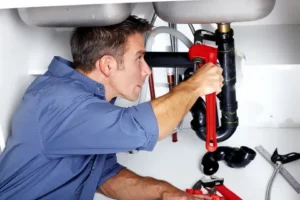Gutter maintenance is an essential part of home care that often goes overlooked. Many homeowners forget to clean their gutters until it becomes a significant issue, leading to costly repairs and potential structural damage. Gutters are designed to direct rainwater away from your home’s foundation, and when they become clogged, they can’t perform their intended function. Preventing gutter clogs doesn’t have to be complicated; with a little effort and a few easy cleaning practices, you can keep your gutter system in optimal shape.
In this article, we’ll explore how to prevent gutter clogs through straightforward and effective cleaning techniques. We’ll cover the importance of gutters, potential risks of clogged systems, easy methods for keeping them clear, and some helpful tools and accessories that can make the job much more manageable.
Why Is It Important to Keep Gutters Clean?
Gutters play a critical role in protecting your home from water damage by collecting rainwater and directing it away from your roof and foundation. When gutters become clogged with leaves, debris, and other obstructions, they can no longer function efficiently. This can lead to water overflowing, pooling around your foundation, and causing a host of problems, including:
- Roof Damage: Standing water can seep into your roof, causing leaks and water damage.
- Foundation Issues: If water isn’t diverted away from your home, it can weaken your foundation, leading to cracks and structural problems.
- Basement Flooding: Water pooling around your foundation can seep into your basement, leading to flooding and mold growth.
- Pest Infestation: Clogged gutters provide an ideal breeding ground for pests such as mosquitoes, rodents, and insects.
To avoid these issues, regular gutter maintenance is crucial. Fortunately, preventing gutter clogs is easier than you might think with the right approach.
Best Practices for Preventing Gutter Clogs
Keeping your gutters clean doesn’t have to be a daunting task. By incorporating some simple preventive measures and regular cleaning, you can keep your gutter system functioning properly and protect your home from water damage. Below are the best practices to prevent gutter clogs:
1. Clean Gutters Regularly
The most effective way to prevent gutter clogs is to clean them regularly. Depending on the number of trees around your property and the local climate, you should aim to clean your gutters at least twice a year—once in the spring and again in the fall. If your home is surrounded by trees that shed leaves and pine needles, you may need to clean them more frequently.
To clean your gutters, follow these steps:
- Gather Your Tools: You’ll need a sturdy ladder, gloves, a trowel or scoop, a bucket or trash bag for collecting debris, and a hose for flushing out the gutters.
- Safety First: Always ensure your ladder is stable and placed on a flat surface. It’s a good idea to have someone hold the ladder while you work. Wear gloves to protect your hands from sharp debris and pests.
- Remove Debris: Use the trowel or scoop to remove leaves, twigs, and other debris from the gutters. Place the debris in the bucket or trash bag as you work your way along the length of the gutter.
- Flush with Water: Once the debris is removed, use a hose to flush out the gutters and downspouts, ensuring that water flows freely through the entire system.
2. Install Gutter Guards
Gutter guards are a simple yet effective way to prevent leaves and debris from accumulating in your gutters. They come in various styles, including mesh screens, foam inserts, and brush guards, each designed to keep debris out while allowing water to flow through.
While gutter guards don’t eliminate the need for cleaning altogether, they significantly reduce the amount of debris that enters the gutters, making maintenance easier and less frequent. Investing in quality gutter guards can save you time and effort while helping to prevent clogs and water damage.
3. Trim Overhanging Branches
If you have trees near your home, overhanging branches can be a major source of gutter clogs. Leaves, twigs, and even small branches can fall into your gutters, leading to blockages. To reduce the amount of debris that ends up in your gutters, trim back any branches that hang over your roof.
This simple preventive measure can minimize the amount of cleaning required and help keep your gutters clear throughout the year. Additionally, trimming branches can reduce the risk of damage to your roof and gutters during storms.
4. Regularly Inspect Downspouts
Downspouts are an essential part of your gutter system, as they carry water away from your home’s foundation. Even if your gutters are clear, clogged downspouts can prevent water from draining properly, leading to overflow and potential damage.
To keep your downspouts clear, regularly inspect them for clogs. You can test the flow by running water through them with a hose. If the water doesn’t flow freely, use a plumbing snake or a high-pressure nozzle to remove the blockage. Ensuring that your downspouts are functioning properly is key to preventing gutter clogs and protecting your home from water damage.
5. Install Downspout Extensions
Downspout extensions help to direct water further away from your home’s foundation, reducing the risk of water pooling and causing damage. By installing downspout extensions, you can ensure that water is safely diverted away from your home, protecting your foundation and landscaping.
Extensions are available in various lengths and materials, and many are flexible, making them easy to install and adjust as needed. By keeping water away from your foundation, you can prevent costly repairs and maintain the structural integrity of your home.
6. Use the Right Tools for Gutter Maintenance
Having the right tools can make gutter cleaning easier and more efficient. Below are some useful tools that can help you maintain your gutters:
- Gutter Scoop: A gutter scoop or trowel is ideal for removing leaves and debris from gutters. It allows you to collect and dispose of debris easily without damaging the gutter.
- Ladder Stabilizer: A ladder stabilizer is an essential safety tool that helps keep your ladder steady and prevents it from leaning on the gutters, which could cause damage.
- Hose Nozzle Attachment: A high-pressure hose nozzle attachment can be used to flush out gutters and downspouts, ensuring that water flows freely and removing any remaining debris.
- Gutter Cleaning Wand: Gutter cleaning wands are long-handled attachments that allow you to clean gutters from the ground, eliminating the need for a ladder in some cases. They are especially useful for homes with multiple stories.
When to Hire a Professional
While gutter cleaning can be a DIY task, there are instances when hiring a professional is the better option. If your home has multiple stories, if you’re uncomfortable working at heights, or if you lack the necessary tools and experience, it may be best to leave gutter cleaning to the professionals.
Professional gutter cleaning services have the equipment and expertise to safely and thoroughly clean your gutters. They can also identify and address potential issues, such as damaged gutters or loose brackets, before they become more significant problems.
The cost of hiring a professional gutter cleaning service is typically reasonable, especially when compared to the potential cost of repairs resulting from neglected gutters. Scheduling regular professional cleanings can give you peace of mind and help protect your home from water damage.
Signs Your Gutters Need Cleaning
To prevent clogs and keep your gutter system functioning properly, it’s important to recognize the signs that your gutters need cleaning. Some common indicators include:
- Water Overflowing: If you notice water spilling over the edges of your gutters during rainfall, it’s a clear sign that they are clogged and need cleaning.
- Sagging Gutters: Excess weight from debris and standing water can cause gutters to sag or pull away from your home.
- Pests and Animals: If you see birds, rodents, or insects around your gutters, they may have taken up residence in the debris. This is a sign that your gutters need cleaning.
- Plant Growth: Plants growing in your gutters indicate a significant buildup of debris and should be addressed immediately.
Conclusion
Preventing gutter clogs is a critical aspect of home maintenance that can protect your home from water damage and costly repairs. By cleaning your gutters regularly, installing gutter guards, trimming overhanging branches, and keeping downspouts clear, you can ensure that your gutter system functions properly and effectively directs rainwater away from your home.
Whether you choose to clean your gutters yourself or hire a professional, taking the time to maintain your gutters is an investment that pays off in the long run. With a few easy cleaning practices and preventive measures, you can keep your gutters clear, safeguard your home, and avoid the headaches associated with water damage. Remember, a little maintenance today can save you a lot of trouble tomorrow.












